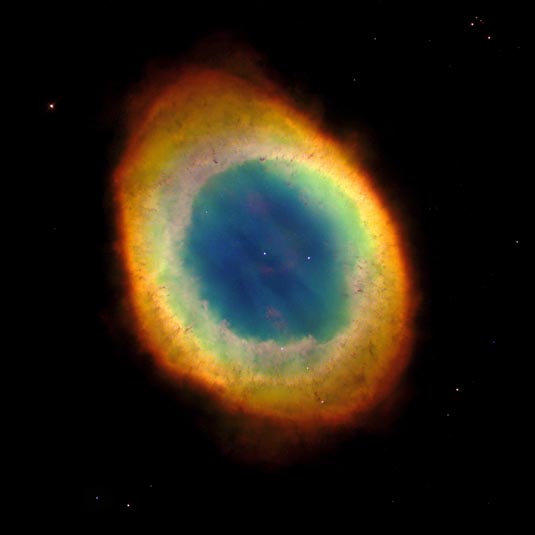
Planetary Nebula
RA 18h 53m 35s Dec. 33° 01' 43"
Lyra
0.7 kpc or 2300 light-years
The image is 2 arcminutes (1.3 light-years) on the veritcal side.
October 16, 1998
1 hour
Red: F658N ([N II]), Green: F501N ([O III]), Blue: F469N (He II)
NASA and The Hubble Heritage Team (STScI/AURA)
January 6, 1999
Spitzer image: n0507
ABOUT THIS IMAGE:
The Ring Nebula is about 2,000 light-years from Earth and has a diameter of about one light-year. The faint speck at its center was once a star of greater mass than our own Sun. Now, near the end of its life, it has ejected its outer layers into space, and the remnant is destined to die as a tiny white dwarf star, about the size of the Earth.
In this colorful image, appearances are deceiving. What looks like an elliptical ring is actually believed to be a barrel-shaped structure surrounding the faint central star, the small white dot in the center. The Ring looks nearly round only because we are looking down the barrel.
Two centuries ago, astronomers studying these round-shaped objects through small telescopes called them "planetary nebulae," because their circular disks resemble those of planets.
Astronomers, however, have suspected for some time that the Ring Nebula actually has a cylindrical shape and looks round only because of the viewing angle. Close examination of the Hubble telescope image, taken by the Wide Field and Planetary Camera 2, strongly supports this newer opinion. The photo shows numerous small dark clouds of dust that have formed in the gas flowing out from the star, and are silhouetted against more distant bright gas. These dense dust clouds are too small to be seen with ground-based telescopes but are easily revealed by the Hubble telescope.
Remarkably,
these finger-like clouds are only seen in the outer portions of the Ring
Nebula; none are seen in the central region. This proves that they are
not distributed in a uniform sphere but are instead located only on the
walls of the barrel. Many of the finger-like clouds point away from the
central star, like spokes on a wheel, due to the forces of radiation and
gas ejected from the dying object.